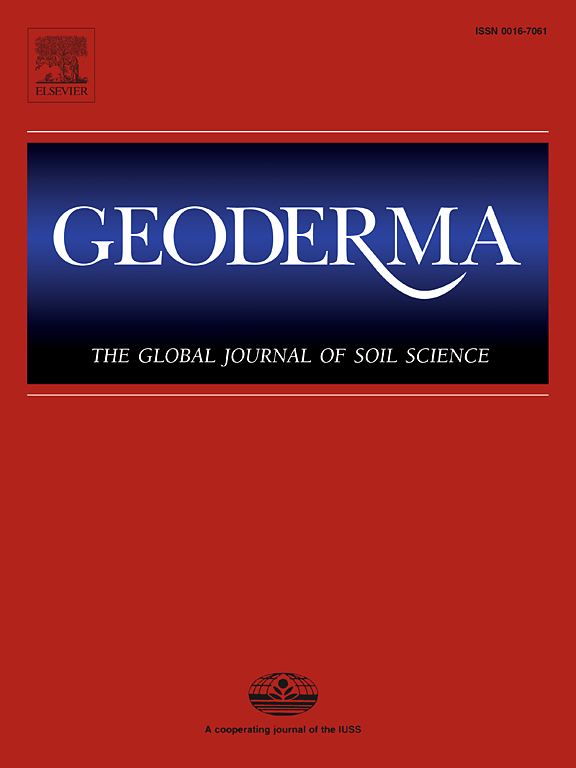TTOP model simulation of long-term (1981–2100) permafrost dynamics of the Tibetan Plateau
IF 5.6
1区 农林科学
Q1 SOIL SCIENCE
引用次数: 0
Abstract
The Tibetan Plateau (TP) covers the largest regions under low- and mid-latitude permafrost. The evolution of permafrost has significantly affected the hydrology, biogeochemistry, and infrastructure of Asia. However, model reconstructions of long-term permafrost evolution with high accuracy and reliability are insufficient. Here, spatial changes in mean annual ground temperature at the depth where the annual amplitude is zero (MAGT) on the TP since 1981 were modeled and validated based on temperature records from 155 boreholes, and future changes were predicted under scenarios from the Climate Model Intercomparison Project 6 (CMIP6). The results indicated that the MAGT on the TP was approximately 1.5 °C (2010 – 2018), and the corresponding permafrost extent on the TP is estimated to be approximately 1.03 × 106 km2, which is projected to decrease to 0.77 × 106, 0.50 × 106, 0.30 × 106, and 0.17 × 106 km2 under the scenarios of shared socioeconomic pathway (SSP)126, SSP245, SSP370, and SSP585, respectively, by 2100. As predicted in the SSP585 scenario, permafrost is predicted to largely disappear from many basins of major Asian rivers, such as the Yarlung Zangpo-Brahmaputra, Nu-Salween, and Lancang-Mekong Rivers, between 2041 and 2060, followed by the Yellow and Yangtze Rivers between 2061 and 2080. Moreover, the original stable permafrost in the West Kunlun Mountains will change to transitional and unstable conditions. Our study offers comprehensive datasets of year-to-year ground temperatures and permafrost extent maps for the TP, which can serve as a fundamental resource for further investigations on the hydrogeology, engineering geology, ecology, and geochemistry of the TP.
青藏高原长期(1981-2100 年)冻土动态的 TTOP 模拟模型
青藏高原(TP)覆盖了低纬度和中纬度永久冻土下最大的区域。多年冻土的演变对亚洲的水文、生物地球化学和基础设施产生了重大影响。然而,高精度、高可靠性的多年冻土演变模型重建还不够。基于155个钻孔的温度记录,对1981年以来青藏高原年振幅为零深度年平均地温的空间变化进行了模拟和验证,并在气候模式比较项目6 (CMIP6)的情景下预测了未来的变化。结果表明:2010—2018年,青藏高原上的MAGT约为1.5°C,相应的冻土面积约为1.03 × 106 km2,到2100年,在共享社会经济路径(SSP)126、SSP245、SSP370和SSP585情景下,冻土面积分别减少至0.77 × 106、0.50 × 106、0.30 × 106和0.17 × 106 km2。根据SSP585情景的预测,预计2041年至2060年间,雅鲁藏布江-雅鲁藏布江、怒江和澜沧江-湄公河等亚洲主要河流的许多流域的永久冻土将基本消失,其次是2061年至2080年间的黄河和长江。此外,西昆仑山原有的稳定冻土将转变为过渡性和不稳定的条件。本研究为青藏高原提供了全面的地温年际数据集和冻土范围图,为青藏高原的水文地质、工程地质、生态和地球化学研究提供了基础资料。
本文章由计算机程序翻译,如有差异,请以英文原文为准。
求助全文
约1分钟内获得全文
求助全文
来源期刊

Geoderma
农林科学-土壤科学
CiteScore
11.80
自引率
6.60%
发文量
597
审稿时长
58 days
期刊介绍:
Geoderma - the global journal of soil science - welcomes authors, readers and soil research from all parts of the world, encourages worldwide soil studies, and embraces all aspects of soil science and its associated pedagogy. The journal particularly welcomes interdisciplinary work focusing on dynamic soil processes and functions across space and time.
 求助内容:
求助内容: 应助结果提醒方式:
应助结果提醒方式:


